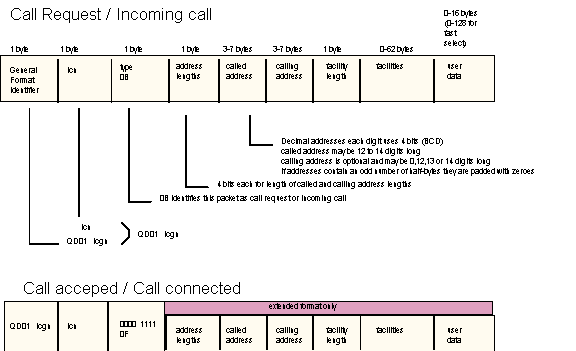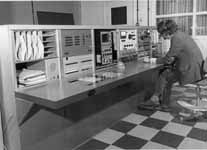1 - Call Setup
1.1 Virtual Circuits

1.2 Successful call set-up
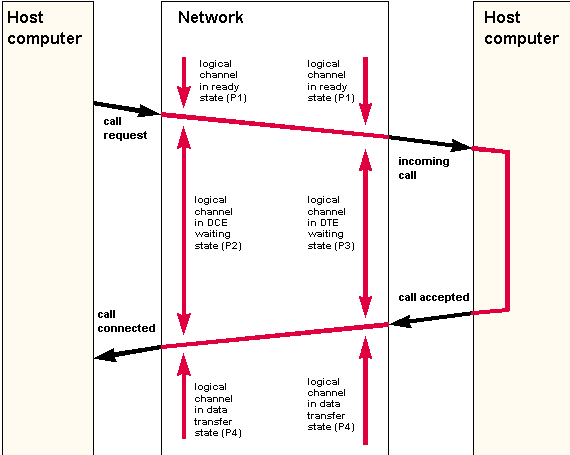
1.3 Unsuccessful call attempt
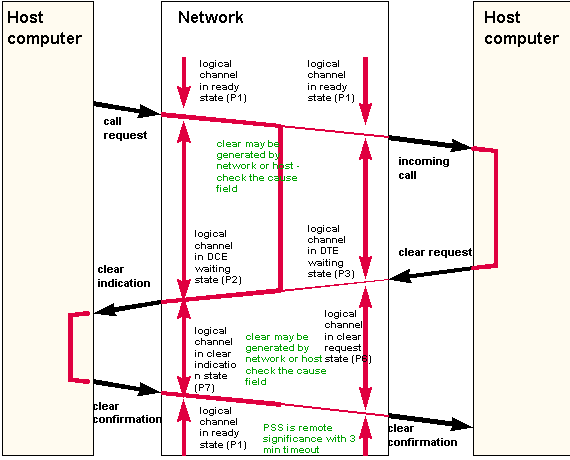
1.4 Subscription time and call setup time facilities
1.5 - Call user data
The user can include up to 16 bytes of data in the call request packet, 128
bytes for fast select.
This field is passed through the network
transparently, The public PAD sets the first 4 bytes, see info on PAD for details.
Protocol identifiers: first 4 bytes of data field
byte number 1 2 3 4
------------------------------------
Public Network pad 01 profile speed 00
Telex network adaptor (IS2) 41 00 00 00
Teletex 02 * * *
Network independent transport
Service (yellow book) 7F FF FF FF
Cable TV 60 * * *
*not defined for identification
note profile coded as follows:
| PAD Profile | Coding |
| A1 | 2D |
| A2 | 2E |
| A3 | 2F |
| A4 | 30 |
| A5 | 31 |
| A6 | 32 |
| A7 | 33 |
| A8 | 34 |
| A9 | 35 |
| B1 | 38 |
| B2 | 39 |
| D1 | 42 |
| D2 | 43 |
| SP | 58 |
| TP | 59 |
| V1 | 5A |
| V2 | 5B |
| V3 | 5C |
| V4 | 5D |
| V5 | 5E |
2 - Call Packet
2.1 CALL REQUEST PACKET
2.2 INCOMING CALL PACKET
2.3 CALL ACCEPTED PACKET
2.4 CALL CONNECTED PACKET
Reverse Charge
Extended Formats
Packet size negotiation
Window size negotiation
Fast select
Closed user group
Call redirection
Multiline
Call Statistics
call is now up and data can be sent
The call request packet is really the same as an incoming call packet, it
is known as a call request packet when it goes from the customers equipment
to the network and an incoming call packet when it goes from the network to
the customers equipment.
Network User Addresses - (NUAs)
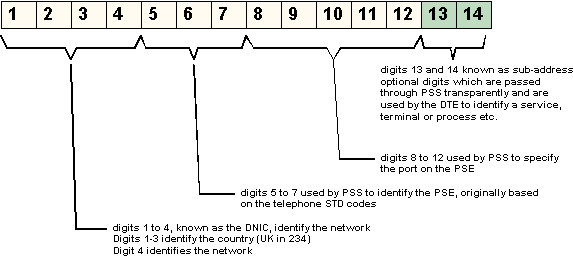
9 - Logical Channel Numbers and Logical Channel Group numbers
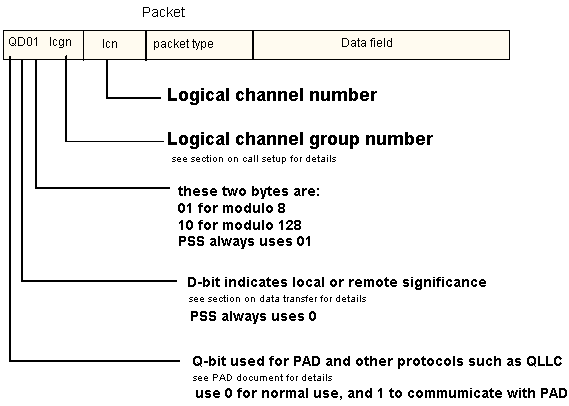
byte 1 - General Format Identifier and Logical Channel Group Number
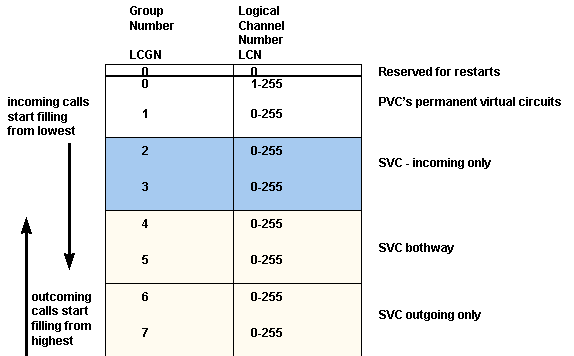
D = Delivery Confirmation Bit (D-bit) - see information on data packets
for details, not used on Public Network must
be set to 0.
LCGN = Logical Channel Group Number
this is an extension to the LCN, see below, and it also indicates the type
of call (PVC,SVC incoming, bothway or outgoing)
PVC = Permanent Virtual Circuit - not currently supported for new connections
to Public Network.
SVC = Switched Virtual Circuit
Byte 2 - Logical Channel Number
This number identifies the call so that subsequent packets on the call do
not have to specify the full address/facilities.
When using bothway SVCs it is possible to get a call collision, that is an
incoming call being received on a logical channel at exactly the same time as
an outgoing call has been sent on that LCN. To minimise this possibility the
network always sends incoming calls on the lowest available LCN and the DTE
should send on the highest available. If a call collision does occur then the
network will proceed with the call request and ignore the incoming call.
8.3 Logical Channel Numbers - LCN
Multiple calls can be sent over a single link, the call is identified by its
Logical group Number.
Since it is an 8-bit number it can only identify 256 calls on its own.
8.4 Logical Channel Group Number - LCGN
This is an extension to the LCN (ie a call on LCN=2 LCGN=4 is different from a call on LCN=2 LCGN=5), also the LCGN identifies
the type of call, see table opposite.
Public Network trunks are not strictly X.25 but they use similar principles although
they use LCGN=0
PVC = permanent virtual circuit , no longer supported by Public Network for new customers
At subscription time, a customer may request how many incoming, bothway and
outgoing channels they wish to subscribe too. Incoming calls, to the customer,
start at the lowest LCN,LCGN and work upwards. Outgoing calls, to the network
start at the highest LCN,LCGN and work down.
This minimises the chances of a call collision on the same LCN,LCGN and allows
the customer to reserve channels for I/C only or O/G only.
The fact that the customer end starts from the highest number means that the
customer must know how many channels they have subscribed to when they configure
their system.
The LCN,LCGN is independent for each link, so if a call is traced through the network the LCN,LCGN may be different for each link.
Subscription Options
The following subscription options may affect call setup
Subscription Option - Direct Call
Extended Packet Sequence Numbering
Local Significance
see D-bit
Subscription Option - D-bit modification
